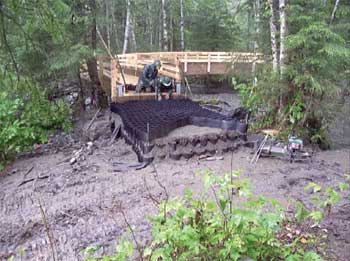Case Studies
The following case studies show how geosynthetic materials were used to solve problems on trails. One of the studies points out problems that can arise if geosynthetic materials are installed improperly.
Geoblocks for ATV TrailsThe Francis Marion National Forest in South Carolina had serious erosion problems on all-terrain vehicle (ATV) trails. The ATVs were causing ruts. Water collecting in the ruts compounded the problem (figure 16). The forest reinforced the trail with Geoblocks, solving the problem (figure 17). Other national forests and national parks now use turf reinforcement products to reduce erosion and reinforce ATV trails.

Figure 16—An ATV trail in South Carolina
before Geoblocks were installed.

Figure 17—The finished trail after Geoblocks were
installed in the Francis Marion National Forest.
The Tongass National Forest in Alaska is using geocells to build approaches for trail bridges (figure 18). In the past, approaches have sloughed off because of the steep embankments and wet conditions there. The geocells have worked wonders and are highly recommended for trail bridge approaches in the Tongass (figure 19).

Figure 18—Using geocells to construct
a trail bridge approach.

Figure 19—A finished trail bridge approach
in the Tongass National Forest.
The Bureau of Land Management in Oregon had trouble with water going over a trail (figure 20). Large rocks were used to create an underdrain (often referred to as a French drain). The large rocks were placed on the ground and a geotextile fabric was laid over the rock (figure 21). The geotextile fabric was used as separation to keep the trail's surface material (crushed rock) from migrating down into the larger rocks. The finished trail (figure 22) allows water to flow through the underdrain.

Figure 20—An ATV Trail on BLM land in
Oregon before geosynthetics were used
to construct an underdrain.

Figure 21—Constructing an underdrain from
large rocks, with geotextile serving as
a separator between surface material
and large rocks.

Figure 22 —A finished rock and
geotextile underdrain.
Trail maintainers had the right idea when they decided to install geocells at the approaches to this bridge (figure 23). The geocells would provide a stable approach to the bridge and keep the fill material from soughing. Unfortunately, they did not install the geocells deep enough to allow 2 to 3 inches of gravel cover above them. The geocells were exposed to traffic and gradually unraveled, creating an unsightly and unsafe approach.

Figure 23—Geocells placed too close to the surface
may unravel.
The top of the geocell should be 2
to 3 inches below the surface of compacted tread fill.

